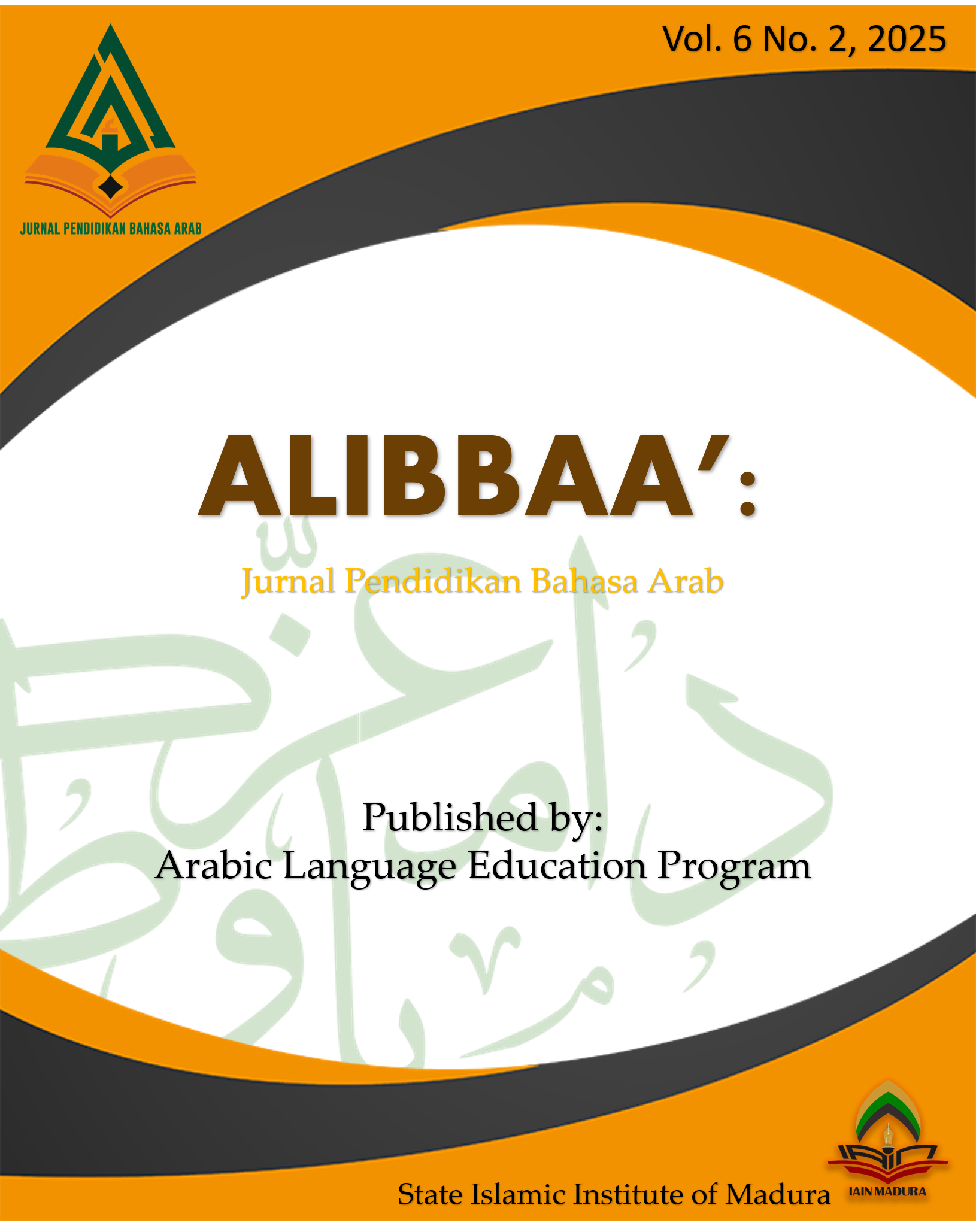Rhetorical Structures of Conclusion Sections in Arabic Scholarly Articles for Indonesian and Arabic Speakers
 Abstract views: 210
,
Abstract views: 210
,
 pdf downloads: 100
pdf downloads: 100
Abstract
This study investigates the rhetorical structures of conclusion sections in Arabic research articles written by Arab native speakers and Indonesian scholars. Using Yang and Allison’s (2003) move-step framework and a directed content analysis approach, the study examined a balanced corpus of 80 articles from linguistics and education journals. The findings reveal that Move 2 (summary of results and evaluation) is obligatory, appearing in all texts, while Move 1 (introduction) and Move 3 (implications and recommendations) are conventional but vary in frequency. Arab authors tended to emphasize Move 3, highlighting implications and prospective contributions, whereas Indonesian authors relied more on Move 1 and Move 2, stressing restatement and summary. Linguistics articles favored Move 2, while education articles highlighted Move 3. The analysis of tense and diathesis further indicates that Arab writers used māḍī (past) to stress finality and majhūl (passive) for impersonal reporting, while Indonesian writers favored muḍāriʿ (present/future) and maʿlūm (active) for generalization and clarity. Theoretically, the study confirms the adaptability of the genre-based move-step framework across languages and disciplines. Practically, it offers pedagogical insights for teaching Arabic academic writing, emphasizing discipline-sensitive genre awareness and rhetorical flexibility
Downloads
References
Abdolmalaki, S. G., H. Tan, A. N. Abdullah, S. Sharmini, and L. Geok Imm. “Introduction Chapter of Traditional and Article-based Theses: A Comparison of Rhetorical Structures and Linguistic Realisations.” GEMA Online® Journal of Language Studies 19, no. 1 (2019): 116–135. https://doi.org/10.17576/gema-2019-1901-07.
Al-Shujairi, Y. B. “Review of the Discussion Section of Research Articles: Rhetorical Structure and Move.” LSP International Journal 8, no. 2 (2021): 9–25. https://doi.org/10.11113/lspi.v8.17099.
Amnuai, Wirada, and Anchalee Wannaruk. “A Move-Based Analysis of the Conclusion Sections of Research Articles Published in International and Thai Journals.” 3L: Language, Linguistics, Literature®: The Southeast Asian Journal of English Language Studies 24, no. 2 (2018): 1–20.
Danis, N. “A Corpus Analysis of Disciplinary Identity in Evaluative Journal Articles: A Systemic Functional Linguistics Approach.” English for Specific Purposes 68 (2022): 87–101. https://doi.org/10.1016/j.esp.2022.07.003.
Deng, Liming, and Jing Liu. “Move–Bundle Connection in Conclusion Sections of Research Articles across Disciplines.” Applied Linguistics 44, no. 3 (2023): 527–554. https://doi.org/10.1093/applin/amac040.
Gao, S., and I. Pramoolsook. “A Cross-Cultural Move Analysis of Electronic Engineering Research Article Introductions: The Case of Chinese, Thai, and Native English Scholarly Writers.” Ampersand 10 (2023): 100106. https://doi.org/10.1016/j.amper.2022.100106.
Hanifa, Zahra Aulia, Mohamad Zaka Al Farisi, dan Rinaldi Supriadi. “Song Lyric Translation Strategies and Techniques: A Case Study of Kun Anta Translation.” ALSUNIYAT: Jurnal Penelitian Bahasa, Sastra, dan Budaya Arab 8, no. 1 (April 2025): 123–36. https://doi.org/10.17509/alsuniyat.v8i1.80788
Hsieh, Hsiu-Fang, and Sarah E. Shannon. “Three Approaches to Qualitative Content Analysis.” Qualitative Health Research 15, no. 9 (November 2005): 1277–1288. https://doi.org/10.1177/1049732305276687.
Huang, Y.-H. C., X. Wang, I. W.-Y. Fong, and Q. Wu. “Examining the Role of Trust in Regulators in Food Safety Risk Assessment: A Cross-regional Analysis of Three Chinese Societies Using an Integrative Framework.” SAGE Open 11, no. 4 (2021). https://doi.org/10.1177/21582440211061579.
Hyland, Ken. “Genre-Based Instruction and Corpora.” TESOL Quarterly 58, no. 3 (2024): 1227–1234. https://doi.org/10.1002/tesq.3273.
Indrian, R. D., and P. Ardi. “Rhetorical Structures of English-Major Undergraduate Thesis Introduction Chapters.” Indonesian Journal of EFL and Linguistics 4, no. 2 (2019): 195. https://doi.org/10.21462/ijefl.v4i2.166.
Kawase, Tomoyuki. “Move Combinations in the Conclusion Section of Applied Linguistics Research Articles.” Pragmatics 35, no. 2 (2025): 185–201. https://doi.org/10.1075/prag.22070.kaw.
Li, X. “Mediating Cross-Cultural Differences in Research Article Rhetorical Moves in Academic Translation: A Pilot Corpus-Based Study of Abstracts.” Lingua 238 (2020): 102795. https://doi.org/10.1016/j.lingua.2020.102795.
Luthfianda, S. N., E. Kurniawan, and W. Gunawan. “Rhetorical Structures of Introductions in Soft and Hard Science International Journals Written by Indonesian Scholars.” Journal of English Language Teaching and Linguistics 6, no. 2 (2021): 343. https://doi.org/10.21462/jeltl.v6i2.563.
“Making Room for Research Promotion in Research Article Discussion/Closing Sections.” English for Specific Purposes 74 (2024): 101. https://doi.org/10.1016/j.esp.2024.100.
Rahimi, Sadegh, and Ali Kashiha. “Modality in the Moves of the Discussion Section of Research Articles.” International Journal of Applied Linguistics (Indonesia) 34, no. 1 (2024): 163–181. https://doi.org/10.17509/ijal.v34i1.
Rustipa, K., S. Purwanto, and F. Rozi. “Rhetorical Structures, Strategies, and Linguistic Features of Problem Statement to Promote a Teaching Writing Model.” Studies in English Language and Education 10, no. 2 (2023): 575–597. https://doi.org/10.24815/siele.v10i2.30855.
Supriadi, Rinaldi, Dadang Sudana, Eri Kurniawan, Mia Nurmala, and Maria Meftahi. “The Use of Tense and Aspect in Arabic: A Comparison of Educational Research Articles by Native and Non-Native Speakers.” Jurnal Al Bayan: Jurnal Jurusan Pendidikan Bahasa Arab 16, no. 2 (2024): 480–500. https://doi.org/10.24042/albayan.v16i2.24421
Tocalo, A. W. I. “Move Structures and Their Rhetorical Verbs of Research Article Abstracts across Englishes.” Indonesian Journal of Applied Linguistics 11, no. 1 (2021). https://doi.org/10.17509/ijal.v11i1.34593.
Wijaya, L., and B. Bram. “Rhetorical Structures of Introduction Sections in Sinta-Indexed Journals.” Jurnal Onoma: Pendidikan, Bahasa, dan Sastra 8, no. 1 (2022): 181–188. https://doi.org/10.30605/onoma.v8i1.1659.
Yang, Ruiying, and Desmond Allison. “Research Article Writing: A Move-Based Genre Analysis of Discussion Sections in Applied Linguistics.” In Academic Discourse, edited by John Flowerdew, 3–22. London: Pearson Education, 2003.
Authors who publish with this journal agree to the following terms:
a. Authors retain copyright and grant the journal right of first publication with the work simultaneously licensed under a Creative Commons Attribution License that allows others to share the work with an acknowledgement of the work's authorship and initial publication in this journal.
b. Authors are able to enter into separate, additional contractual arrangements for the non-exclusive distribution of the journal's published version of the work (e.g., post it to an institutional repository or publish it in a book), with an acknowledgement of its initial publication in this journal.
c. Authors are permitted and encouraged to post their work online (e.g., in institutional repositories or on their website) prior to and during the submission process, as it can lead to productive exchanges, as well as earlier and greater citation of published work (See The Effect of Open Access).
Alibbaa': Jurnal Pendidikan Bahasa Arab have CC-BY-SA or an equivalent license as the optimal license for the publication, distribution, use, and reuse of scholarly work.
In developing strategy and setting priorities, Alibbaa': Jurnal Pendidikan Bahasa Arab recognize that free access is better than priced access, libre access is better than free access, and libre under CC-BY-SA or the equivalent is better than libre under more restrictive open licenses. We should achieve what we can when we can. We should not delay achieving free in order to achieve libre, and we should not stop with free when we can achieve libre.

Alibbaa': Jurnal Pendidikan Bahasa Arab is licensed under a Creative Commons Attribution 4.0 International License
You are free to:
- Share — copy and redistribute the material in any medium or format
- Adapt — remix, transform, and build upon the material for any purpose, even commercially.
- The licensor cannot revoke these freedoms as long as you follow the license terms.











